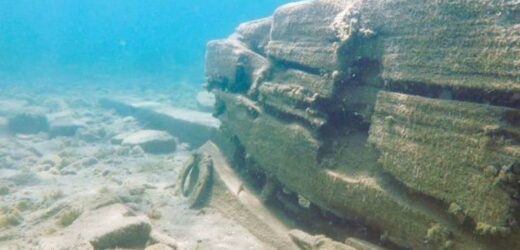Japan: Volcano eruptions cause WWII shipwrecks to surface
We use your sign-up to provide content in ways you’ve consented to and to improve our understanding of you. This may include adverts from us and 3rd parties based on our understanding. You can unsubscribe at any time. More info
The Griffin, a large vessel built by French explorer René-Robert Cavalier, Sieur de La Salle, disappeared on its maiden voyage some 343 years ago. Ever since, it has remained one of America’s most notorious maritime mysteries. It was built with the intention of finding a route through North America’s Great Lakes to reach China and Japan. But, while delivering a valuable cargo of furs, it vanished amid rumours that she had been cursed by a prophet from the indigenous Iroquois tribe.
Since its disappearance, it has been widely considered the ‘Holy Grail’ for Great Lakes shipwreck hunters.
Often considered the first ship lost on the Great Lakes, little was known about it until shipwreck hunters Stevie and Kathie Libert set to work.
Their findings are detailed in the 2021 book ‘Le Griffon and the Huron Islands — 1679: Our Story of Explorations and Discovery’.
Mr and Mrs Libert claim The Griffin matches wreckage found in 2018 near Poverty Island in Lake Michigan.
Likewise, they claim a bowsprit discovered a few miles away in 2001 is another part of the vessel.


La Salle never found out what happened to his ship.
Mr Libert said: “There are numerous theories as to what happened to The Griffin.
“Father Louis Hennepin said it was lost in a violent storm.
“Some say that the native Indians boarded the ship and killed the crew. They then set the ship on fire.
“Many believed the Jesuits were responsible for the ship’s disappearance.

“La Salle was certain that the captain and his men committed mutiny, sank the ship and absconded with all the furs.”
Legend has it that natives cursed the ship, after Metiomek, an Iroquois prophet, apparently told La Salle that the ship was cursed and would sink in deep waters.
The Griffin is then said to have become a ghost ship, with the crew apparently heard chanting as she sails among the clouds on moonlit evenings.
The wreckage, however, suggests the storm was the most feasible theory.
Mr Libert said: “The ship has no indications of fire damage to the wooden remains. We are confident the ship was wrecked due to a severe storm.
DON’T MISS:
Mountain range disappeared into Yellowstone supervolcano magma chamber [INSIGHT]
Scientists stunned at ‘perfect’ Ice Age discovery: ‘Could have died… [REVEALED]
Mary Rose breakthrough: Ship was ‘six minutes from being saved’ [QUOTES]

“The distance of 3.8 miles between the bowsprit and main sections highly suggests the Indians did not sink it either, nor did La Salle’s men mutiny and sink the ship.
“If any of the latter was true the ship would rest in deeper water instead of shallow waters.”
The Griffin, Mr Libert believes, was caught in a four-day storm. The bowsprit is believed to have broken off before the rest of the ship sank.
The cargo of furs, with an estimated value of £640,000 in today’s money, likely sank with her.
Carbon dating of the bowsprit estimated an age range within a year of The Griffin’s sinking in 1679.

The other nearby wreckage, meanwhile, had been dated to between 1632 and 1982.
Mr Libert explained the discovery had been long in the making, sparked by a history teacher when he was still at school.
He said: “My interest began the day my teacher reached over and touched my shoulder, and said out loud in class, ‘Maybe one day, someone in this class will find it.’
“Fifty-one years later, I am still intrigued by this story.”
Yet the battle to find The Griffin has been riddled with issues.
After the discovery of the bowsprit, a 10-year legal battle with the State of Michigan prevented explorers from excavating the rest of the ship. Only then did Mr Libert and various archaeologists discover that the bowsprit and the remainder of the vessel were separate.
After two years sifting through satellite imagery, Mr Libert found what he believed was the rest of the wreck, and this was later confirmed in a September 2018 dive.
He recalled: “I was emotionally drained of all my energy, and was in a complete state of relief and exhaustion, but I could still yell out the words ‘We found it!’ once I broke the surface.”
The State of Michigan continues to prevent an in-depth excavation. According to Mr Libert, the state “feels we are encroaching upon their sovereignty and feels we are nothing more than treasure hunters intruding on the rights of academia and archaeologists”.
Mr Libert will continue to search the bed of Lake Michigan using non-intrusive techniques, with the ultimate aim of finding a cannon with the date stamped on it.
‘Le Griffon and the Huron Islands – 1679: Our Story of Exploration and Discovery’ was written by Mr and Mrs Libert and published by Mission Point Press in 2021. It is available here.
Source: Read Full Article


